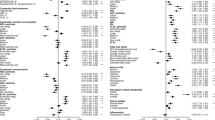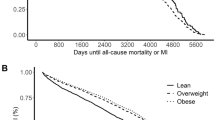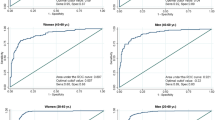Abstract
OBJECTIVES: The present study aimed at evaluating the prevalence of the Metabolic Syndrome and at identifying its additional clinical features.
RESEARCH DESIGN AND METHODS: Within a prospective population-based survey examining 888 subjects aged 40–79 y, subjects were identified fulfilling the WHO and the National Cholesterol Education Program-Adult Treatment Panel III (NCEP-ATPIII) criteria for diagnosing the Metabolic Syndrome. In these subjects and in the rest of the sample (controls), several metabolic and nonmetabolic biochemical parameters were compared.
RESULTS: The prevalence of the Metabolic Syndrome by WHO criteria was 34.1% (95% CI 31.0–37.2) and by NCEP-ATPIII criteria 17.8% (15.5–20.3). The prevalence was significantly higher in older subjects and in those less physically active. Subjects with the Metabolic Syndrome either by WHO or by NCEP-ATPIII criteria showed higher levels of oxidized low-density lipoprotein, apolipoprotein B, urate, leptin, fibrinogen, leukocytes, erythrocyte sedimentation rate, GOT, gamma-GT and soluble endothelial adhesion molecules (E-selectin, vascular adhesion molecule-1 and intercellular adhesion molecule-1) and lower apolipoprotein A concentrations. Insulin resistance, as assessed by the Homeostasis Model Assessment, increased with the increase in the number of traits composing the syndrome found within the single individual. Subjects with insulin resistance had more pronounced abnormalities in several parameters, including the additional features of the syndrome (eg fibrinogen and soluble adhesion molecules).
CONCLUSIONS: The Metabolic Syndrome occurs very frequently in the general population aged 40–79 y, and is associated with several additional metabolic and nonmetabolic abnormalities that likely contribute to an increased cardiovascular risk. Insulin resistance seems to play a major role in classic and additional abnormalities featuring the Metabolic Syndrome.
This is a preview of subscription content, access via your institution
Access options
Subscribe to this journal
Receive 12 print issues and online access
$259.00 per year
only $21.58 per issue
Buy this article
- Purchase on Springer Link
- Instant access to full article PDF
Prices may be subject to local taxes which are calculated during checkout

Similar content being viewed by others
References
Zavaroni I, Bonora E, Pagliara M, Dall'Aglio E, Luchetti L, Buonanno G, Bonati PA, Bergonzani M, Gnudi L, Passeri M, Reaven G . Risk factors for coronary artery disease in healthy persons with hyperinsulinemia and normal glucose tolerance. N Engl J Med 1989; 320: 703–706.
Haffner SM, Valdez RA, Hazuda HH, Mitchell BD, Morales PA, Stern MP . Prospective analysis of the insulin resistance syndrome (Syndrome X). Diabetes 1992; 41: 715–722.
Meigs JB, D'Agostino RB, Wilson PWF, Cupples LA, Nathan DM, Singer DE . Risk variable clustering in the insulin resistance syndrome. Diabetes 1997; 46: 1594–1600.
Reaven GM . Banting lecture. Role of insulin resistance in human disease. Diabetes 1988; 37: 1595–1607.
DeFronzo RA, Ferrannini E . Insulin resistance: a multifaceted syndrome responsible for NIDDM, obesity, hypertension, dyslipidemia and atherosclerotic cardiovascular disease. Diabetes Care 1991; 14: 173–194.
Ferrannini E, Haffner SM, Mitchell BD, Stern MP . Hyperinsulinemia: the key feature of a cardiovascular and metabolic syndrome. Diabetologia 1991; 34: 416–422.
WHO Consultation.Definition, diagnosis and classification of diabetes mellitus and its complications. Part 1: Diagnosis and classification of diabetes mellitus. World Health Organization: Geneva, Switzerland; 1999.
Expert Panel on Detection, Evaluation and Treatment of High Blood Cholesterol in Adults. Executive summary of the third report of the National Cholesterol Education Program (NCEP) Expert Panel on Detection, Evaluation and Treatment of High Blood Cholesterol in Adults (Adult Treatment Panel III). JAMA 2001; 285: 2486–2497.
Willeit J, Kiechl S . Prevalence and risk factors of asymptomatic extra-cranial carotid artery atherosclerosis. A population-based study. Arterioscl Thromb 1993; 13: 661–668.
Kiechl S, Werner P, Egger G, Oberhollenzer F, Mayr M, Xu Q, Poewe W, Willeit J . Active and passive smoking, chronic infections and the risk of carotid atherosclerosis. Prospective results from the Bruneck Study. Stroke 2002; 33: 2170–2176.
Kiechl S, Willeit J, Rungger G, Egger G, Oberhollenzer F, Bonora E for the Bruneck Study Group. Alcohol consumption and atherosclerosis. What is the relation? Prospective results from the Bruneck Study. Stroke 1998; 29: 900–907.
Saltin B, Grimby G . Physiological analysis of middle-aged and older former athletes. Comparison of still active athletes of the same ages. Circulation 1968; 38: 1104–1115.
Friedewald WT, Levy RI, Fredrickson DS . Estimation of the concentration of low-density lipoprotein cholesterol in plasma without use of preparative ultracentrifuge. Clin Chem 1972; 18: 499–502.
Balkau B, Charles MA for the European Group for the Study of Insulin Resistance. Comment to the provisional report from the WHO Consultation. Diabetic Med 1999; 16: 442–443.
Matthews DR, Hosker JP, Rudenski AS, Naylor BA, Treacher DF, Turner RC . Homeostasis model assessment: insulin resistance and beta-cell function from fasting plasma glucose and insulin concentrations in man. Diabetologia 1985; 28: 412–419.
Bonora E, Targher G, Alberiche M, Bonadonna RC, Saggiani F, Zenere MB, Monauni T, Muggeo M . Homeostasis Model Assessment closely mirrors the glucose clamp technique in the assessment of insulin resistance. Studies in subjects with various degrees of glucose tolerance and insulin sensitivity. Diabetes Care 2000; 23: 57–63.
Muggeo M, Verlato G, Bonora E, Bressan G, Girotto S, Corbellini M, Gemma ML, Moghetti P, Zenere M, Cacciatori V, Zoppini G, De Marco R . The Verona Diabetes Study: a population-based survey on known diabetes mellitus prevalence and 5-year all-cause mortality. Diabetologia 1995; 38: 318–325.
Isomaa B, Almgren P, Tuomi T, Forsén B, Lahti K, Nissén M, Taskinen MR, Groop L . Cardiovascular morbidity and mortality associated with the metabolic syndrome. Diabetes Care 2001; 24: 683–689.
Ford ES, Giles WH, Dietz WH . Prevalence of the Metabolic Syndrome among US adults. Findings from the Third National Health and Nutrition Examination Survey. JAMA 2002; 287: 356–359.
Pagano R, La Vecchia C, De Carli A, Negri E, Franceschi S . Trends in overweight and obesity among Italian adults, 1983 through 1994. Am J Public Health 1997; 87: 1869–1870.
VanItallie TB . Prevalence of obesity. Endocrinol Metab N Am 1996; 25: 887–905.
King H, Aubert RE, Herman WH . Global burden of diabetes, 1995–2025. Prevalence, numerical estimates, and projections. Diabetes Care 1998; 21: 1414–1431.
Bonora E, Kiechl S, Willeit J, Oberhollenzer F, Egger G, Bonadonna RC, Muggeo M . Carotid atherosclerosis and coronary heart disease in the metabolic syndrome prospective data from the Bruneck Study. Diabetes Care 2003; 26: 1251–1257.
Helmrick SP, Ragland DR, Leung RW, Paffenbarger RS . Physical activity and reduced occurrence of non-insulin-dependent diabetes. N Engl J Med 1991; 325:147–152.
Sallis JF, Patterson TL, Buouno MJ, Nader PR . Relationship of physical fitness and physical activity to cardiovascular risk factors in children and adults. Am J Epidemiol 1988; 127: 933–941.
Zavaroni I, Bonati PA, Luchetti L, Bonora E, Buonanno G, Bergonzani M, Pagliara M, Gnudi L, Butturini L, Passeri M, Reaven GM . Habitual leisure-time physical activity is associated with differences in various risk factors for coronary artery disease. J Intern Med 1989; 226: 417–421.
Blair SN, Goodyear NN, Gibbons LW, Cooper SK . Physical fitness and incidence of hypertension in healthy normotensive men and women. JAMA 1984; 252: 487–490.
Imperatore G, Riccardi G, Iovine C, Rivellese AA, Vaccaro O . Plasma fibrinogen: a new factor of the metabolic syndrome. Diabetes Care 1998; 21: 649–654.
Pickup JC, Mattock MB, Chusney GD, Burt D . NIDDM as a disease of the innate immune system: association of acute-phase reactants and interleukin-6 with metabolic syndrome X. Diabetologia 1997; 40: 1286–1292.
Leyva F, Godsland IF, Ghatei M, Proudler AJ, Aldis S, Walton C, Bloom S, Stevenson JC . Hyperleptinemia as a component of a metabolic syndrome of cardiovascular risk. Arterioscler Thromb Vasc Biol 1998; 18: 928–933.
Lee KU . Oxidative stress markers in Korean subjects with insulin resistance syndrome. Diabetes Res Clin Pract 2001; 54 (Suppl 2) S29–S33.
Festa A, D'Agostino Jr R, Howard G, Mykkanen L, Tracy RP, Haffner SM . Chronic subclinical inflammation as part of the insulin resistance syndrome. The Insulin Resistance Atherosclerosis Study (IRAS). Circulation 2000; 102: 42–47.
Marceau P, Biron S, Hould FS, Marceau S, Simard S, Thung SN, Kral JG . Liver pathology and the metabolic syndrome X in severe obesity. J Clin Endocrinol Metab 1999; 84: 1513–1517.
Friedman JM, Halaas JL . Leptin and the regulation of body weight in mammals. Nature 1998; 395: 763–770.
Hamilton BS, Paglia D, Kwan AYM, Deitel M . Increased obese mRNA expression in omental fat cells from massively obese humans. Nat Med 1995; 1: 950–953.
Arch JRS, Stock MJ, Trayhurn P . Leptin resistance in obese humans: does it exist and what does it mean? Int J Obesity Relat Metab Disord 1998; 22: 1159–1163.
Friedman-Einat M, Camoin L, Faltin Z, Rosenblum CI, Kaliouta V, Eshdat Y, Strosberg AD . Serujm leptin activity in obese and lean patients. Regul Pept 2003; 111: 77–82.
Panza JA, Quyyumi AA, Brush Jr JE, Epstein SE . Abnormal endothelium-dependent relaxation in patients with essential hypertension. N Engl J Med 1990; 323: 22–27.
Casino RC, Kilcoyne CM, Quyyumi AA, Hoeg JM, Panza JA . The role of nitric oxide in endothelium-dependent vasodilation of hypercholesterolemic patients. Circulation 1993; 88: 2541–2547.
Williams SB, Goldfine AB, Timinmi FK, Ting HH, Roddy MA, Simonson DC, Creager MA . Acute hyperglycemia attenuates endothelium-dependent vasodilation in humans in vivo. Circulation 1998; 97: 1695–1701.
Pinkney JH, Stehouver CDA, Coppack SW, Yudkin JS . Endothelial dysfunction: cause of the Insulin Resistance Syndrome. Diabetes 1997; 46 (Suppl 2): S9–S13.
Vuorinen-Markkola H, Yki-Jarvinen H . Hyperuricemia and insulin resistance. J Clin Endocrinol Metab 1994; 78: 25–29.
Kennedy A, Gettys TW, Watson P, Wallace P, Ganaway E, Pan Q, Garvey WT . The metabolic significance of leptin in humans: gender-based differences in relationship to adiposity, insulin sensitivity and energy expenditure. J Clin Endocrinol Metab 1997; 82: 1293–1300.
Baron A . Insulin resistance and vascular function. J Diabetes Complications 2002; 16: 92–102.
Weyer C, Yudkin JS, Stehouwer CD, Schalkwijk CG, Pratley RE, Tataranni PA . Humoral markers of inflammation and endothelial dysfunction in relation to adiposity and in vivo insulin action in Pima Indians. Atherosclerosis 2002; 161: 233–242.
Juhan-Vague I, Thompson SG, Jespersen J . Involvement of the hemostatic system in the insulin resistance syndrome. A study of 1500 patients with angina pectoris. The ECAT Angina Pectoris Study Group. Arterioscl Thromb 1993; 13: 1865–1873.
Kurucz I, Morva A, Vaag A, Eriksson KF, Huang X, Groop L, Koranyi L . Decreased expression of heat shock protein 72 in skeletal muscle of patients with type 2 diabetes correlates with insulin resistance. Diabetes 2002; 51: 1102–1109.
Marchesini G, Brizi M, Bianchi G, Tomassetti S, Bugianesi E, Lenzi M, McCullogh AJ, Natale S, Forlani G, Melchionda N . Nonalcoholic fatty liver disease: a feature of the metabolic syndrome. Diabetes 2001; 50: 1844–1850.
Acknowledgements
This research was supported by grants from the Italian National Research Council, the Italian Ministry of University and Scientific and Technological Research and the Health Department of the Veneto Region (Ricerca Sanitaria Finalizzata Regionale). The skilful technical assistance of Anna Pierotti, Monica Zardini, Federica Moschetta and Jessica Beccaletto is acknowledged.
Author information
Authors and Affiliations
Corresponding author
Rights and permissions
About this article
Cite this article
Bonora, E., Kiechl, S., Willeit, J. et al. Metabolic Syndrome: epidemiology and more extensive phenotypic description. Cross-sectional data from the Bruneck Study. Int J Obes 27, 1283–1289 (2003). https://doi.org/10.1038/sj.ijo.0802381
Received:
Revised:
Accepted:
Published:
Issue Date:
DOI: https://doi.org/10.1038/sj.ijo.0802381
Keywords
This article is cited by
-
Association of apolipoproteins and lipoprotein(a) with metabolic syndrome: a systematic review and meta-analysis
Lipids in Health and Disease (2023)
-
Targeting hypercoagulation to alleviate Alzheimer’s disease progression in metabolic syndrome
International Journal of Obesity (2022)
-
Identification of metabolic syndrome using phenotypes consisting of triglyceride levels with anthropometric indices in Korean adults
BMC Endocrine Disorders (2020)
-
Dissecting metabolic syndrome components: data from an epidemiologic survey in a genetic isolate
SpringerPlus (2015)
-
Excess body mass index loss predicts metabolic syndrome remission after gastric bypass
Diabetology & Metabolic Syndrome (2014)



